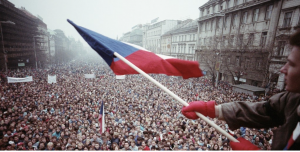Czechoslovakia, 1989

November 17, 1989
Kafkadesk, “On this Day, in 1989: a student protest in Prague sparked the Velvet Revolution.”
On November 17, 1989, nearly 200,000 students marched on Wenceslas Square in Prague in a non-violent protest of the one party government (Communist Party of Czechoslovakia). Over the next 3 days, the student demonstration would more than doubled in size, as 500,000 dissidents from all ages and backgrounds now walked in the protest. Before the end of the week, General Secretary Miloš Jakeš, along with the rest of the Communist Party leadership would resign, freeing the country of two generations of Communist oppression. The 5 week peaceful protest became known as the Velvet Revolution, dismantling the prior command economy and forging a new nation of democratic elections.
The Velvet Revolution was significant to contributing to a reversal of the Domino Theory. President Eisenhower originally depicted the falling of a domino as adjacent countries falling to the influence of Communism. But in 1989, Czechoslovakia joined the end of Communist regimes for Poland, Hungary, and East Germany. These nations became the focus of Cold War media. In Wenceslas Square, the protest was globally televised. The U.S. and other democratic nations rejoiced at the sight of Czechs singing along to performances of formerly banned singers like Marta Kubišová, Karel Kryl, and Karel Gott. The revolutionary landscape was one of waving flags, relief, and jubilance. Though the movements in Prague represented most of the nation, the feelings were not unanimous. Czechs from rural outlets perhaps benefited from the State controlled economy, as the job and life security provided to them was seen as a fair trade for loss of freedoms of speech or expression. Miners and other risky professions shared a similar sense of gratitude for the protection offered in a Socialist-state, and worried capitalism would curtail their privileges. The class dynamics in Communism v. Capitalism was exhibited within the fear working class groups possessed for the revolutionary success of young, educated protestors. And how the New York Times covered the events of the Velvet Revolution supported an argument that the sentiments of rural populations were largely ignored. Their speech would be just as choked by a capitalism regime as a communist one.
Although minority resistance of the Revolution existed, the New York Times perceived a consensus of triumph for Czechoslovakia in November of 1989. At the end of the first week, the underground press was flourishing, and prints on everything Prague could be found on the walls, windows, and sidewalks of streets. Esther Fein of the Times had assumed students spent hours on computers, type-writers, and even wall-painted messages as a means of “spreading the word about the opposition movement”. Fein told a narrative of students using interviews and videos, and even subway worker speaker systems to voice details of the rally. The Times used headlines of Civic Forum leader Jan Urban’s quote, “It’s a war on walls,” to illustrate how the protest was built through a peaceful method of wall writings across the city. Lewis Anthony, writing for the Times in Prague at the time, emphasized how the “hopes of millions around the world,” were devastated by the totalitarianism seen in Prague Spring (1968). But that this ensuing revolution was going to replace those memories. He wrote how “crucial” and impressive the development of students’ posters and flyers had overcome the censorship of police secured television studios. The Times was sympathetic to 40 years of oppression in Czechoslovakia. As they described the “brutality” of the regime once in power, they applauded the student protestors for maintaining non-violent principles even when there was police brutality. Ultimately, the Times was captivated by the pace of an overthrow with peaceful measures, and delivered back home to the U.S. news of global Democratic victory.
Bibliography:
Ilana Hartikainen. “THE VELVET REVOLUTION IN THE REGIONS: What took ten years in
Poland took ten days in Czechoslovakia. But, as some Czechs would discover, not all revolutions are equal.” History Today. (December 1, 2019).
Esther B. Feins. “If the Party has its Back to the Wall, it’s a Wall with New Posters on it: Reporter’s Notebook.” New York Times (1923-Current File), Nov 27, 1989. 1, http://newman.richmond.edu:2048/login?url=https://www.proquest.com/historical-newspapers/if-party-has-back-wall-with-new-posters-on/docview/110360078/se-2?accountid=14731.
Lewis, Anthony. “‘if there was Light’.” New York Times (1923-Current File), Nov 26, 1989. 1, http://newman.richmond.edu:2048/login?url=https://www.proquest.com/historical-newspapers/if-there-was-light/docview/110306127/se-2?accountid=14731.
